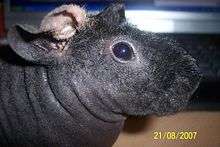Skinny pig
The Skinny pig or just Skinny is an almost hairless breed of guinea pig. Skinny pigs typically have hair on their muzzles, feet, and legs, but are hairless over the remainder of their bodies. Some of them have a thin covering of fuzzy hair on their backs as well. A healthy Skinny has skin that is mostly smooth with some wrinkling around the legs and neck, the body is full with no appearance of spine or ribs. Skinnies can come in a variety of skin colours and patterns, such as Dutch, Tortoiseshell, Himalayan and many others. "Skinny" is the term used for hairless guinea pigs either because it colloquially refers to the exposed skin of the animal, or else it describes the illusion of their visually thinner appearance.
 Adult female Skinny pig | |
| Nicknames | Cavy |
|---|---|
| Country of origin | Canada |
| Traits | |
| Lifespan | 5-7 years |
| Fur type | Mostly hairless |
| |
The modern breed of Skinny pig originated with a cross between haired guinea pigs and a hairless lab strain. The hairless strain that it is most likely related to was a spontaneous genetic mutation that was first identified at Montreal's Armand Frappier Institute in 1978, in a colony of Hartley lab guinea pigs. In 1982 they were sent to Charles River Laboratories to be bred for laboratory use and are commonly used in dermatology studies today.[1] They are an outbred strain that has an intact thymus[2] and normal immune system.[3]
Unique traits

Hairless guinea pigs are not significantly physiologically different than regular haired guinea pigs,[4] although they need to eat more to maintain body heat. The optimal temperature range for a hairless guinea pig is 75 to 79 °F (24 to 26 °C), which is slightly higher than the optimal temperature range for the haired guinea pig.[5]
Their sensitive skin has very much the same appearance as human skin,[6][7] but has the same needs as normal guinea pig skin. Exposed skin is vulnerable to sunburn, other injuries and fungal infections unless precautions are taken.[4] Skinny pigs should be housed indoors and they are usually kept with nesting materials such as a blanket or cloth bag for heat conservation.[4] The breeding protocol for Skinny pigs require outcrossing to haired carriers at least every other generation.[4] This is an important step in the breeding process, which makes them a poor choice for novice breeders. Skinny pigs are born nearly hairless and must maintain the same level of hair through their life.
"Werewolf" is a slang term for skinny pigs with more hair than usual, extending up over the face and onto the neck and shoulders. Extremely hairy werewolf skinny pigs will have hair all the way down to their rump. Werewolves typically gain and lose fur based on hormone levels, especially hormones related to pregnancy.[8]

The gene causing hairlessness in skinny pigs is a recessive gene, and breeding two skinny pigs together will always result in all offspring being skinny pigs. Breeding a skinny pig to a standard haired guinea pig will result in offspring that all carry one copy of the gene, but none will express hairlessness.[9] These offspring are generally called skinny carriers. Breeding two skinny carriers together will (on average) result in 25% offspring being skinny pigs, 50% offspring being skinny carriers and 25% offspring being regular haired guinea pigs that do not carry the gene.[10] Since the chance of getting a skinny pig is low, and because it is not possible to visually tell the difference between a haired guinea pig that does carry the gene and one that does not, this method of breeding is not recommended.
Haired Skinny carriers remain haired (looking like a normal guinea pig) their entire life but carry the hairless gene.
There is a second type of hairless guinea pig called the Baldwin guinea pig and its hairlessness is the result of a completely different recessive gene. Breeding a skinny pig with a Baldwin guinea pig will result in offspring that all are haired and carry one copy of the gene for skinny pig hairlessness and one copy of the gene for Baldwin hairlessness.[10]
Even though the Skinny is a relatively new breed among pet owners and cavy fanciers, it is gaining popularity in Canada, Europe, Scandinavia, and Russia as well as in the United States where it was introduced into the pet trade in the mid-to-late 1990s.
See also
- Nude mouse
- Naked mole rat
- List of guinea pig breeds
- Baldwin guinea pig
Notes
- http://www.criver.com/products-services/basic-research/find-a-model/iaf-hairless-guinea-pig-(1)
- USAMRIID Seminar Series February 17, 1989
- http://www.hillary.net/school/lab_animal/labanimal.lec.11.03.98
- "GuineaLynx-Records". GuineaLynx. Retrieved 25 November 2017.
- Banks, Ron. "The Guinea Pig: Biology, Care, Identification, Nomenclature, Breeding and Genetics". Washington University in St. Louis. USAMRIID Seminar Series. Retrieved 25 November 2017.
- Sueki, H.; Gammal, C.; Kudoh, A.M. Kligman (2000). "Hairless guinea pig skin: anatomical basis for studies of cutaneous biology". European Journal of Dermatology. John Libbey Eurotext. 10 (5): 357–64.
- "Hairless guinea pig skin: anatomical basis for studies of cutaneous biology". John Libbey Eurotext.
- "Cavy Genetics - Basics of the Breeds". Minifluffs Rabbitry. Retrieved 25 November 2017.
- McLeod, DVM, Lianne. "Hairless Guinea Pigs". The Spruce. The Spruce. Retrieved 28 November 2017.
- "Considerations for Breeding". American Hairless Cavy Society. AHCS-Online. Retrieved 28 December 2017.
References
- http://www.jle.com/en/revues/medecine/ejd/e-docs/00/01/8A/21/article.md
- http://www.criver.com/products-services/basic-research/find-a-model/iaf-hairless-guinea-pig-(1)
- http://netvet.wustl.edu/species/guinea/guinpig.txt
- http://www.hillary.net/school/lab_animal/labanimal.lec.11.03.98
- http://www.guinealynx.info/records/viewtopic.php?t=43